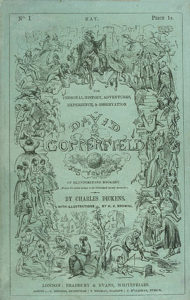
Charles John Huffam Dickens (7 February 1812–9 June 1870) was an English writer and social critic. He created some of the world’s best-known fictional characters and is regarded by many as the greatest novelist of the Victorian era. Dickens left school to work in a factory when his father was incarcerated in a debtors’ prison. Despite his lack of formal education, he edited a weekly journal for 20 years, wrote 15 novels, five novellas, hundreds of short stories and non-fiction articles, lectured and performed readings extensively, was an indefatigable letter writer, and campaigned vigorously for children’s rights, education, and other social reforms.
His literary success began with the 1836 serial publication of ‘The Pickwick Papers’. The instalment format allowed Dickens to evaluate his audience’s reaction, and he often modified his plot and character development based on such feedback
‘David Copperfield’ is widely regarded as a veiled autobiography of Dickens. In the words of the author, this novel was “a very complicated weaving of truth and invention”. In the preface to the 1867 edition, Dickens wrote, “like many fond parents, I have in my heart of hearts a favourite child. And his name is David Copperfield.”

Dickens was also known for his philanthropy and, having been approached by Angela Burdett Coutts, heir to the Coutts banking fortune, he founded a home for the redemption of fallen women of the working class. The home, named “Urania Cottage” was in the Lime Grove area of Shepherds Bush. He managed it for ten years, setting the house rules, reviewing the accounts and interviewing prospective residents. Emigration and marriage were central to Dickens’ agenda for the women on leaving Urania Cottage, from which it is estimated that about 100 women graduated between 1847 and 1859.
On 9 June 1865, while returning from Paris with his mistress Ellen Ternan, Dickens was involved in the Staplehurst rail crash. The train’s first seven carriages plunged off a cast iron bridge that was under repair. The only first-class carriage to remain on the track was the one in which Dickens was travelling. Before rescuers arrived, Dickens tended and comforted the wounded and the dying with a flask of brandy and a hat refreshed with water, and saved some lives. Before leaving, he remembered the unfinished manuscript for ‘Our Mutual Friend’ and he returned to his carriage to retrieve it. Dickens later used the experience of the crash as material for his short ghost story ‘The Signal-Man’ in which the central character has a premonition of his own death in a rail crash.
The Charles Dickens Museum in London is the historic home where he wrote ‘Oliver Twist’, ‘The Pickwick Papers’ and ‘Nicholas Nickleby’.

Join the discussion
0 people are already talking about this, why not let us know what you think?